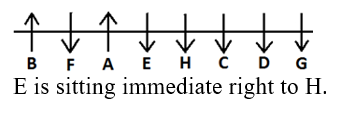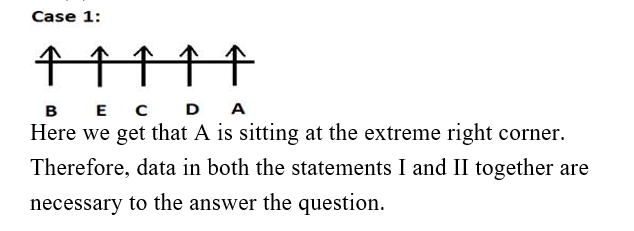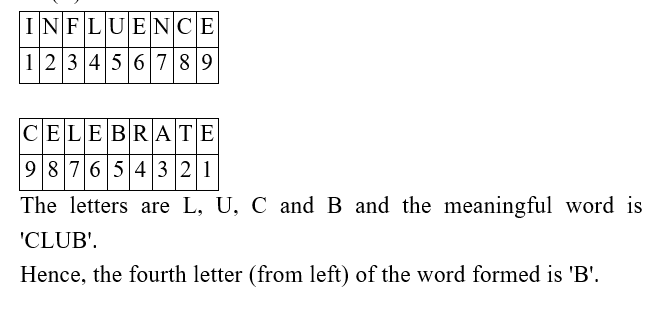Question 1:
Directions: Study the given information and answer the following questions based on it.
निर्देश: दी गई सूचना का अध्ययन कीजिए और उसके आधार पर निम्नलिखित प्रश्नों के उत्तर दीजिए।
Eight persons - A, B, C, D, E, F, G and H are sitting horizontally on eight different chairs from left to right facing either north or south but not in the same order.
Two persons are sitting between F and H and both faces southwards. B is sitting at an extreme end and F is sitting immediate right of B. C is sitting second to the right of G who does not sit immediate next to H. A is sitting third to the right of C. Immediate neighbours of C faces same direction as C who faces opposite of the direction of A. D is sitting to the left of E.
आठ व्यक्ति - A, B, C, D, E, F, G और H आठ अलग-अलग कुर्सियों पर क्षैतिज रूप से बाईं ओर से दाईं ओर या तो उत्तर या दक्षिण की ओर मुखरित होकर बैठे हैं लेकिन समान क्रम में नहीं बैठे हैं।
F और H के बीच दो व्यक्ति बैठे हैं तथा दोनों दक्षिण की ओर मुखरित हैं। B चरम छोर पर बैठा है और F, B के निकटस्थ दाईं ओर बैठा है। C, G के दाईं ओर दूसरे स्थान पर बैठा है और G, H के ठीक आगे नहीं बैठा है। A, C के दाईं ओर तीसरे
स्थान पर बैठा है। C का निकटस्थ पड़ोसी, C के समान दिशा की ओर मुखरित है और C, A के विपरीत दिशा
Who is sitting immediate right to H?
H के निकटस्थ दाईं ओर कौन बैठा है?
Question 2:
Directions: Study the given information and answer the following questions based on it.
निर्देश: दी गई सूचना का अध्ययन कीजिए और उसके आधार पर निम्नलिखित प्रश्नों के उत्तर दीजिए।
Eight persons - A, B, C, D, E, F, G and H are sitting horizontally on eight different chairs from left to right facing either north or south but not in the same order.
Two persons are sitting between F and H and both faces southwards. B is sitting at an extreme end and F is sitting immediate right of B. C is sitting second to the right of G who does not sit immediate next to H. A is sitting third to the right of C. Immediate neighbours of C faces same direction as C who faces opposite of the direction of A. D is sitting to the left of E.
आठ व्यक्ति - A, B, C, D, E, F, G और H आठ अलग-अलग कुर्सियों पर क्षैतिज रूप से बाईं ओर से दाईं ओर या तो उत्तर या दक्षिण की ओर मुखरित होकर बैठे हैं लेकिन समान क्रम में नहीं बैठे हैं।
F और H के बीच दो व्यक्ति बैठे हैं तथा दोनों दक्षिण की ओर मुखरित हैं। B चरम छोर पर बैठा है और F, B के निकटस्थ दाईं ओर बैठा है। C, G के दाईं ओर दूसरे स्थान पर बैठा है और G, H के ठीक आगे नहीं बैठा है। A, C के दाईं ओर तीसरे
स्थान पर बैठा है। C का निकटस्थ पड़ोसी, C के समान दिशा की ओर मुखरित है और C, A के विपरीत दिशा
Who is sitting exactly between A and D?
A और D के ठीक बीच में कौन बैठा है?
Question 3:
Directions: Study the given information and answer the following questions based on it.
निर्देश: दी गई सूचना का अध्ययन कीजिए और उसके आधार पर निम्नलिखित प्रश्नों के उत्तर दीजिए।
Eight persons - A, B, C, D, E, F, G and H are sitting horizontally on eight different chairs from left to right facing either north or south but not in the same order.
Two persons are sitting between F and H and both faces southwards. B is sitting at an extreme end and F is sitting immediate right of B. C is sitting second to the right of G who does not sit immediate next to H. A is sitting third to the right of C. Immediate neighbours of C faces same direction as C who faces opposite of the direction of A. D is sitting to the left of E.
आठ व्यक्ति - A, B, C, D, E, F, G और H आठ अलग-अलग कुर्सियों पर क्षैतिज रूप से बाईं ओर से दाईं ओर या तो उत्तर या दक्षिण की ओर मुखरित होकर बैठे हैं लेकिन समान क्रम में नहीं बैठे हैं।
F और H के बीच दो व्यक्ति बैठे हैं तथा दोनों दक्षिण की ओर मुखरित हैं। B चरम छोर पर बैठा है और F, B के निकटस्थ दाईं ओर बैठा है। C, G के दाईं ओर दूसरे स्थान पर बैठा है और G, H के ठीक आगे नहीं बैठा है। A, C के दाईं ओर तीसरे
स्थान पर बैठा है। C का निकटस्थ पड़ोसी, C के समान दिशा की ओर मुखरित है और C, A के विपरीत दिशा
How many persons are sitting between B and C?
B और C के बीच में कितने व्यक्ति बैठे हैं?
Question 4:
Directions: Study the given information and answer the following questions based on it.
निर्देश: दी गई सूचना का अध्ययन कीजिए और उसके आधार पर निम्नलिखित प्रश्नों के उत्तर दीजिए।
Eight persons - A, B, C, D, E, F, G and H are sitting horizontally on eight different chairs from left to right facing either north or south but not in the same order.
Two persons are sitting between F and H and both faces southwards. B is sitting at an extreme end and F is sitting immediate right of B. C is sitting second to the right of G who does not sit immediate next to H. A is sitting third to the right of C. Immediate neighbours of C faces same direction as C who faces opposite of the direction of A. D is sitting to the left of E.
आठ व्यक्ति - A, B, C, D, E, F, G और H आठ अलग-अलग कुर्सियों पर क्षैतिज रूप से बाईं ओर से दाईं ओर या तो उत्तर या दक्षिण की ओर मुखरित होकर बैठे हैं लेकिन समान क्रम में नहीं बैठे हैं।
F और H के बीच दो व्यक्ति बैठे हैं तथा दोनों दक्षिण की ओर मुखरित हैं। B चरम छोर पर बैठा है और F, B के निकटस्थ दाईं ओर बैठा है। C, G के दाईं ओर दूसरे स्थान पर बैठा है और G, H के ठीक आगे नहीं बैठा है। A, C के दाईं ओर तीसरे
स्थान पर बैठा है। C का निकटस्थ पड़ोसी, C के समान दिशा की ओर मुखरित है और C, A के विपरीत दिशा
D is related to G, F is related to B in the same way E is related to ____.
जिस तरह से D, G से संबंधित है, F, B से संबंधित है, उसी तरह E, ____ से संबंधित है।
Question 5:
Directions: Study the given information and answer the following questions based on it.
निर्देश: दी गई सूचना का अध्ययन कीजिए और उसके आधार पर निम्नलिखित प्रश्नों के उत्तर दीजिए।
Eight persons - A, B, C, D, E, F, G and H are sitting horizontally on eight different chairs from left to right facing either north or south but not in the same order.
Two persons are sitting between F and H and both faces southwards. B is sitting at an extreme end and F is sitting immediate right of B. C is sitting second to the right of G who does not sit immediate next to H. A is sitting third to the right of C. Immediate neighbours of C faces same direction as C who faces opposite of the direction of A. D is sitting to the left of E.
आठ व्यक्ति - A, B, C, D, E, F, G और H आठ अलग-अलग कुर्सियों पर क्षैतिज रूप से बाईं ओर से दाईं ओर या तो उत्तर या दक्षिण की ओर मुखरित होकर बैठे हैं लेकिन समान क्रम में नहीं बैठे हैं।
F और H के बीच दो व्यक्ति बैठे हैं तथा दोनों दक्षिण की ओर मुखरित हैं। B चरम छोर पर बैठा है और F, B के निकटस्थ दाईं ओर बैठा है। C, G के दाईं ओर दूसरे स्थान पर बैठा है और G, H के ठीक आगे नहीं बैठा है। A, C के दाईं ओर तीसरे
स्थान पर बैठा है। C का निकटस्थ पड़ोसी, C के समान दिशा की ओर मुखरित है और C, A के विपरीत दिशा
Which pair among the following is sitting at extreme ends?
निम्नलिखित में से कौन-सा युग्म अंतिम छोर पर बैठा है?
Question 6:
Which of the following symbols should replace the question marks respectively so that 'F < P' is definitely true?
निम्नलिखित में से कौन-सा चिन्ह क्रमशः प्रश्न चिह्न के स्थान पर होना चाहिए ताकि 'F <P' निश्चित रूप से सत्य हो?
P ? Q = R ? S = F < T > U
Question 7:
If two is subtracted from each digit at odd place and three is added to each digit at even place(starting from left) in the number 3670749 how many digits will appear twice in the new number thus formed?
यदि संख्या 3670749 में (बाएँ से प्रारंभ करते हुए) विषम स्थान के प्रत्येक अंक में से दो घटाया जाता है और सम स्थान के प्रत्येक अंक में तीन जोड़ा जाता है, तो इस प्रकार बनी नई संख्या में कितने अंक दो बार आएंगे?
Question 8:
The question given below consists of two statements numbered I and II given below it. You have to decide whether the data given in the statements are sufficient to answer the question.
नीचे एक प्रश्न और उसके नीचे दो कथन संख्यांकित I और II दिए गए हैं। आपको यह निर्धारित करना है कि कथनों में दी गई सूचना प्रश्न का उत्तर देने के लिए पर्याप्त है या नहीं।
Five persons - Punam, Riya, Sonam, Tania and Veena are of different height. Who is the second tallest person
पाँच व्यक्तियों - पूनम, रिया, सोनम, तानिया और वीना के कद अलग-अलग हैं। दूसरा सबसे लम्बा व्यक्ति कौन है?
Statement I: Only Sonam is taller than Veena.
कथन I: केवल सोनम, वीना से कद में लम्बी है।
Statement II: Tania and Veena are shorter than Riya.
कथन II: तानिया और वीना, रिया से कद में नाटी हैं।
Question 9:
Two statements numbered I and II are given below. You have to decide whether the data provided in the statements are sufficient to answer the question.
नीचे दो कथन संख्यांकित I और II दिए गए हैं। आपको यह निर्धारित करना है कि कथनों में दी गई सूचना प्रश्न का उत्तर देने के लिए पर्याप्त है या नहीं।
Five friends - A, B, C, D and E are studying in a college and all of them are sitting on a horizontal bench facing north direction. Who is sitting at the extreme right corner?
पांच मित्र - A, B, C, D और E एक कॉलेज में पढ़ते हैं और वे सभी एक क्षैतिज बेंच पर उत्तर दिशा की ओर मुखरित होकर बैठे हैं। चरम दायें कोने पर कौन बैठा है?
Statement I: Two friends are sitting between B and D. A is immediate right to D who does not sit at any of the extreme ends.
कथन I: B और D के बीच में दो मित्र बैठे हैं। A, D के निकटस्थ दायें बैठा है और D किसी भी चरम अंत पर नहीं बैठा है।
Statement II: E is sitting immediate left to C.
कथन II: E, C के निकटस्थ बायें बैठा है।
Question 10:
If a meaningful four lettered word can be formed using the 4th and 5th letters (from left) of the word 'INFLUENCE' and using the 5th and 9th letters (from right) of the word 'CELEBRATE', then what is the fourth letter (from left) of the word formed?
If no such meaningful word can be formed, mark X as your answer and if more than one meaningful words can be formed, mark Y as your answer.
यदि शब्द 'INFLUENCE' के (बाईं ओर से) चौथे और पाँचवें अक्षरों तथा शब्द 'CELEBRATE' के (दाईं ओर से) पाँचवें और नौवें अक्षरों का उपयोग करके चार अक्षरों वाला एक अर्थपूर्ण शब्द बनाया जा सकता है, तो इस प्रकार बनाए गए शब्द का चौथा अक्षर (बाईं ओर से) क्या होगा?
यदि ऐसा कोई अर्थपूर्ण शब्द नहीं बनाया जा सकता है, तो अपने उत्तर के रूप में X को चिह्नित कीजिए और यदि एक से अधिक ऐसे अर्थपूर्ण शब्द बनाए जा सकते हैं, तो अपने उत्तर के रूप में Y को चिह्नित कीजिए।



